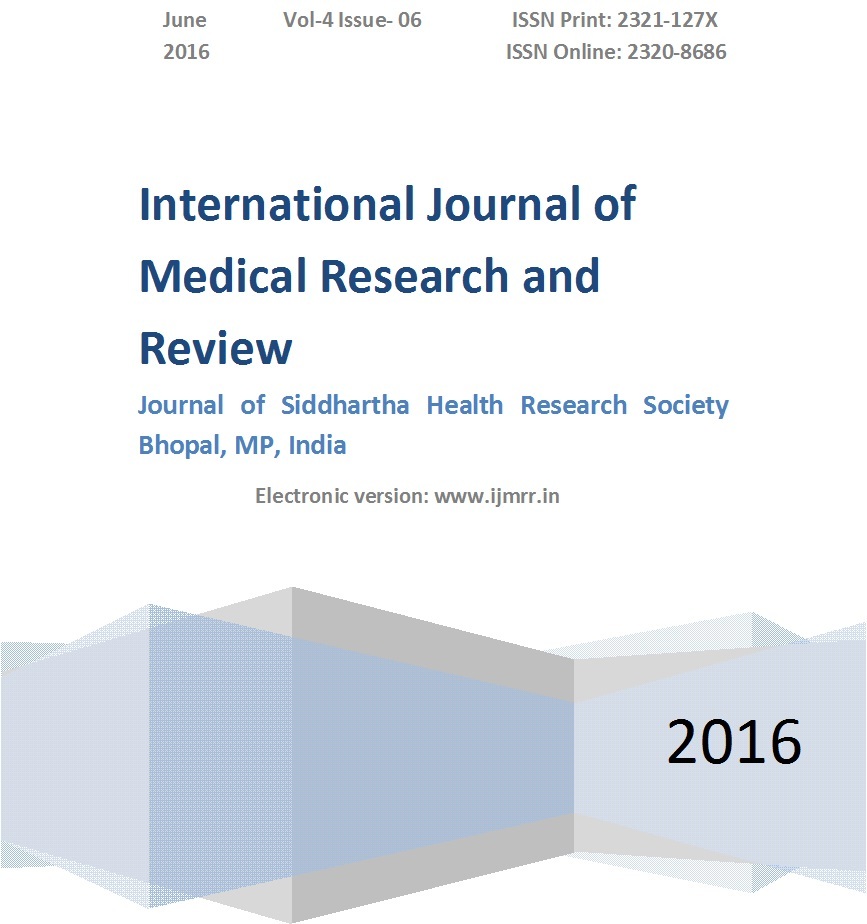Prevalence of ESBL-mediated Resistance among Hospital and Community isolates of Klebsiella pneumoniae in Warangal
Abstract
Introduction: Extended Spectrum β-Lactamase (ESBL) producing Klebsiella pneumoniae were prevalent in the hospital environment and were responsible for many hospital associated infections (HAIs).The present study was aimed at identifying these strains in the hospital environment so as to guide the clinician in planning antibiotic policy.
Material and Methods: 200 clinical isolates of Klebsiella pneumoniae constituted the study group.100 isolates were from the community and 100 from the hospital. Based on their susceptibility or resistance to 3rd generation cephalosporins (3GCs), the isolates were characterized into two groups. Group I consisted of sensitive strains(128 numbers) which showed a zone diameter of more than 17mm and group II consisted of resistant strains(72 numbers) which showed a zone diameter of less than 17mm to ceftazidime (30µg), cefotaxime (30µg) and ceftriaxone (30µg). Isolates of group II were tested for ESBL production using two methods namely double disc synergy test (DDST) and phenotypic confirmatory disc diffusion test (PCDDT).
Results: Among the 72 resistant strains, 36 (50%) were ESBL producers and 36 (50%) were non-ESBL producers. Among the hospital isolates, the percentage of ESBL producers was more (30%) compared to the community isolates (6%).
Conclusion: About one third of the hospital isolates of Klebsiella pneumoniae showed ESBL production whereas ESBL mediated resistance was low in community isolates. This study substantiated the need for planning proper antibiotic policy to reduce mortality due to Gram-negative sepsis.
Downloads
References
2. Mahon CR and Manuselis, Jr. Enterobacteriaceae In: Text book of Diagnostic Microbiology, 1995.W.B. Saunders Company, a Division of Harcourt Brace & company. Philadelphia LondonTorontoMontreal Sydney Tokyo. 456-457.
3. Subha A, Ananthan S. Extended spectrum beta lactamase (ESBL) mediated resistance to third generation cephalosporins among Klebsiella pneumoniae in Chennai. Indian Journal of Medical Microbiology, (2002) 20(2):92-95.
4. Jarlier V, Nicolas M, Foumier G, Philippon A. Extended spectrum β-lactamases conferring transferable resistance to newer β-lactam agents in Enterobacteriaceae: Hospital prevalence and susceptibility patterns. Rev Infect Dis 1988; 867-78.
5. Clinical Laboratory Standards: Performance standards for antimicrobial susceptibility testing;Eighth informational supplement. M100-S8. NCCLS, Wayne, PA: 1998; 7767 Clinical and Laboratory Standards Institute. 2005 guidelines by CSLI/NCCLS – CSLI informational supplement. Approved standard M100-S15 Wayne, PA; 200;565.
6. Paterson DL and Bonomo RA. Extended-spectrum β-lactamases: a Clinical Update. Clinical, Microbiology Reviews.Oct. 2005.p. 657-686.
7. National Committee for Clinical Laboratory standards: performance Standards for antimicrobial susceptibility test, 5th ed. (Villanova, PA: NCCLS) 1993: DOCUMENT M2 – A5.
8. Eisen, D., E.G. Rusell, M. Tymms, E., J. Rper, M.L., Grayson, and J. Turnidge, 1995, Randomamplified polymorphic DNA.
9. Revathi G, Singh S. Detection of Expanded spectrum cephalosporin Resistance due to inducibleβ-lactamases in hospital isolates. Indian J Med Microbiol 1997; 15 (3):113-115.
10. Subha A, Ananthan S. Extended spectrum beta lactamase (ESBL) mediated resistance to thirdgeneration cephalosporins among Klebsiella pneumoniae in Chennai. Indian Journal of Medical Microbiology, (2002) 20(2):92-95.
11. Shukla I, Tiwari R, Agarwal M. Prevalence of Extended Spectrum β-lactamase ProducingKlebsiellapneumoniae in a Tertiary Care Hospital, Indian Journal of Medical Microbiology.(2004)(2): 87-91.
12. Singhal S, Mathur T, Khan S, Upadhyay DJ, Chug S, Giand R, Rattan A. Evaluation of methods forAmpC β-lactamase in Gram-negative clinical isolates from tertiary care hospitals. IndianJournal of Medical Microbiology, (2005) 23 (2): 120-124.
13. Menon T, Bindu D, Kumar CPG, Nalini S, Thiruvarayan MA. Comparison of Double Disc andThree Dimensional Methods to screen for ESBL producers in a Tertiary Care Hospital. Indian Journal of Medical Microbiology. (2006) 24 (2): 117-120.
14. Lucet JC, Decre D, Fichelle A, Joly-Guillou ML, Pernet M, Deblangye, et al.Control of a prolonged outbreak of Extended spectrum β-lactamase producing Enterobacteriaceae in a University Hospital.Clin Infect Dis 1999; 29:1411-8.
15. Mathur P, Kapil A, Das B, Dhawan B. Prevalance of ESBL Producing Gram-negative bacteria in a tertiary care hospital. Indian J Medical Res 2002; 115:153-157.



 OAI - Open Archives Initiative
OAI - Open Archives Initiative


